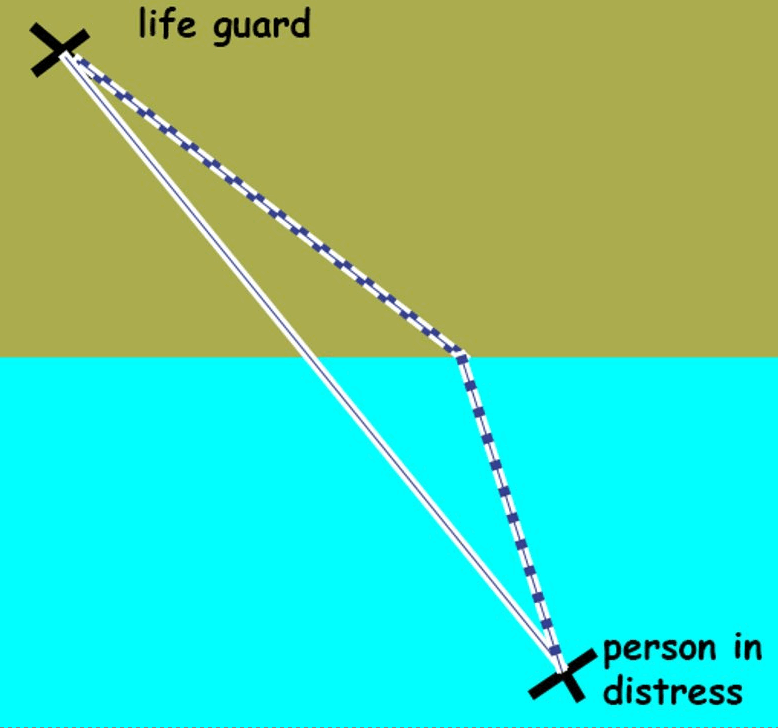Physics > Waves > The principle of least time
The development of physical theories
The first table with data from refraction experiments was produced by the Greek mathematician Claudius Ptolomy, born in 100 AD, who was best known for his works on astronomy. His table had refraction data for light refracting at an interface between air and water. This experimental work was unusual for the Greeks, who traditionally didn´t perform practical experiments and focused on thought experiments and on the philosophy of science and other disciplines.
The next step on the development of the theory of light refraction was to obtain a mathematical relationship that could reproduce the results on the refraction tables. That only happened hundreds of years later, in 1621 when Willebrord Snell, a Dutch mathematician, finally discovered the formula that related these numbers .
It is very satisfying to have a mathematical formula that explains the results. Maths is considered as the language of nature because all observed phenomena can be explained by a mathematical formula, that can also be used to predict further results, sometimes still unknown. But it would be nice to have more than a formula. Scientists also try to go further and obtain some sort of explanation .
This latest development came in about 1650 with another mathematician: Fermat. He discovered the Principle of least time.
the Principle of least time
The idea is very simple: light rays take the path that takes the least time! It may sound a bit weird because it sounds like light is choosing which way to go, and always doing the correct decision... But it works very well. Let´s see some applications.
The principle of least time explains why , regarding reflection on a mirror, the incident angle equals the reflected angle. If light comes from a point A to reach a point B after reflecting on the mirror, there are lots of possible paths. It can be calculated that , among all the possible paths, the path that takes the least time is the one where the incident and reflected angles are equal.
Now let´s see how this principle explain Snell´s law of refraction. First let´s think of an analogy, using the image below:

analogy of refraction using life guard in a beach: brown is sand and blue is water
On the image above we see 2 paths for the life guard to reach the person in distress in the sea. The life guard can follow many different paths to reach the person in the water, but it is important that he/she gets there within the least possible time. Let´s simplify our discussion and consider only the 2 paths shown on the image. Many people would think that the straight line path would be quicker, but it is not. The dotted line (bent) represents the quickest way to save the person in distress. Why?
The life guard will get to the person in distress quicker following the bent path because he/she can run much faster than swim. So if more time is spent running, and less time swimming, the total time taken will be less. You could calculate lots of different paths to find out that the quickest is something like the bent line shown, and not the straight line.
The case of light is very similar. Instead of water with have a medium with a higher refractive index , so that light travels at a lower speed. A s a result light must bend to cover the whole path in the least possible time!
The principle of least time also leads to reciprocity principle, that is , that the path the light takes to cross a block of glass (like that shown on this page) is the same either way it goes, from right to left or from left to right.
Other uses of the least time principle
If we observe the sunken it is about to set, it is already below the horizon! That is because the light that moves from the sun to our eyes is bent due to refraction. This is best understood using the least time principle because Snell´s law deal with straight lines, and in this case we have a curve. Light bends because it can travel faster through the highest layers of the atmosphere, where the air is less dense.
A similar phenomenon happens when you look at a road, in a sunny day, and it looks wet. When you get close you see that it was not wet: it was an illusion ( called a mirage). That happens because the light rays moving from the sun to your eyes are bent when they get close to the surface of the road, so that they look like coming fro the road. This happens because the high temperature of the road heats up the air and makes it less dense. Again, light can travel faster in a less dense medium and the principle of least time explains why the bent trajectory is chosen.
